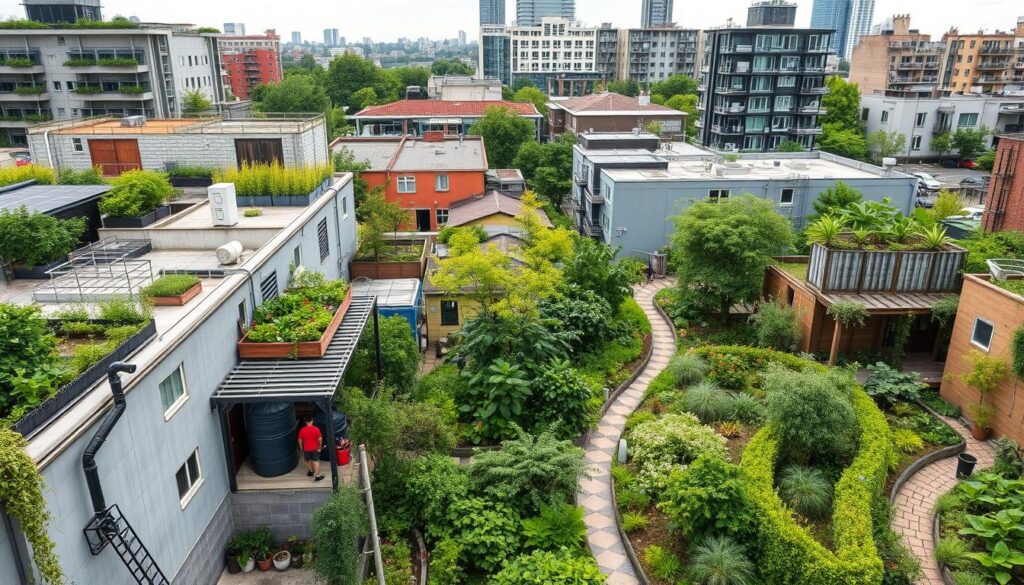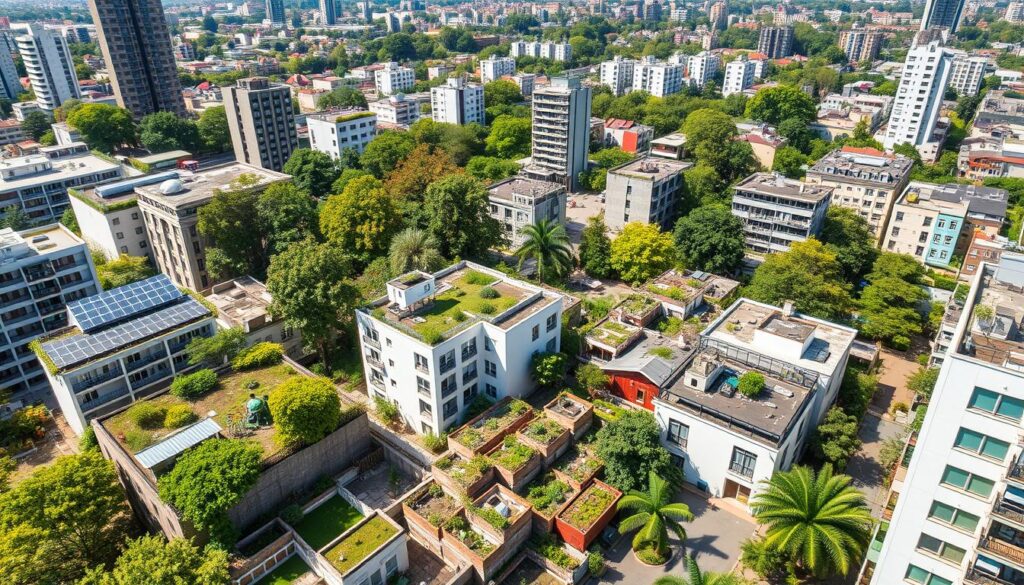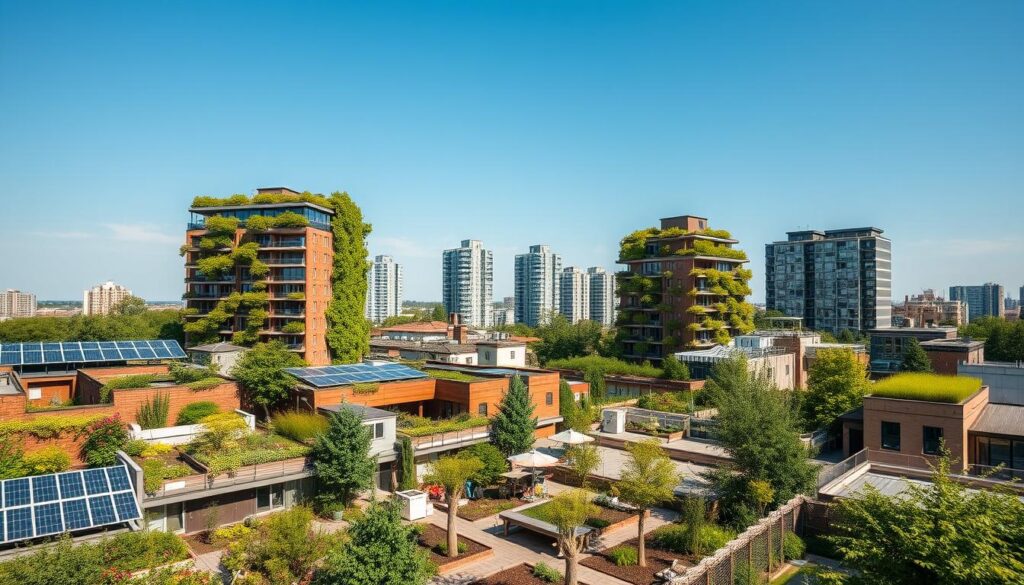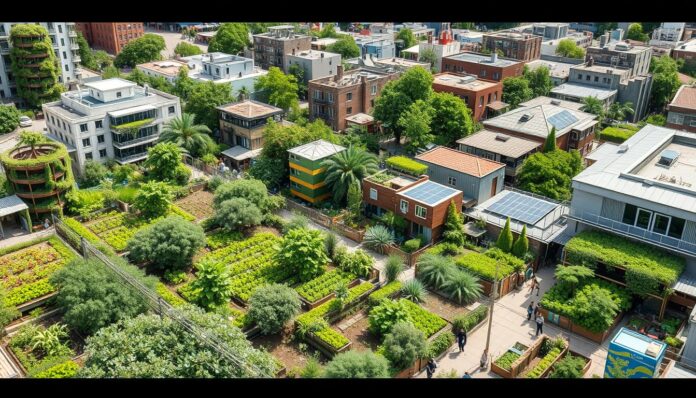Permaculture urban zoning is a way to make cities better and greener. It divides land into zones based on how often we use them. This method cuts down on energy use and makes living in the city better.
Using permaculture zoning makes cities more eco-friendly. It groups land into zones, with Zone 1 being closest to homes and needing daily care. Zone 5 is for wild areas that don’t need much attention. This system helps cities design better, greener spaces.
Introduction to Permaculture Zoning
Permaculture zoning is key for making cities sustainable. It helps us understand how to use land wisely. By knowing about different zones, cities can plan better and make greener spaces.
Key Takeaways
- Permaculture urban zoning is a design system that aims to create efficient and sustainable urban environments.
- The zoning system divides the land into different zones based on their frequency of use and distance from the center of activity.
- Zone 1 requires daily attention and is typically used for herb and vegetable gardens.
- Permaculture urban zoning promotes sustainable city planning and urban permaculture design.
- The zoning system allows for a flexible approach to urban permaculture design, enabling cities to create sustainable and efficient environments.
- Permaculture urban zoning can help reduce energy consumption and promote eco-friendly practices.
Understanding Permaculture Principles
Permaculture principles are key for green urban planning. They are based on caring for the earth, people, and sharing fairly. These ideas help us build sustainable and eco-friendly systems.
Key Concepts of Permaculture
Permaculture is a way to design systems that are good for the planet. It looks at how plants, animals, and people interact. By using permaculture, we can make cities that are both green and productive.
The Ethics of Permaculture
The ethics of permaculture are its core values. They are earth care, people care, and fair share. Earth care means protecting nature. People care is about making communities healthy. Fair share is about sharing resources equally.
Zones and Sectors Explained
In permaculture, zones and sectors help organize systems. Zones are areas like homes and gardens. Sectors are directions like sunlight and wind. Understanding these helps make permaculture systems more efficient.
- Reduced water run-off by approximately 30%
- Enhanced local biodiversity by providing a habitat for 100+ species of native plants
- Increased yield of edible crops by up to 400%
- Improved community engagement and social connections
By using permaculture, we can make cities better for the future. We can create sustainable and resilient places for everyone.
The Importance of Urban Zoning in Permaculture
Urban zoning is key in permaculture. It helps make cities sustainable, resilient, and livable. By using urban sustainability practices and urban land use planning, cities can be greener. They can use less energy and support more biodiversity.
This method is vital for designing and managing urban areas. It considers the special challenges and chances of city life.
Effective permaculture urban zoning means knowing its pros and cons. Some benefits include:
- More food from urban gardens
- Better air and water quality
- More biodiversity and ecosystem services
But, there are also challenges. These include limited space, contaminated soil, and rules that get in the way. To beat these, urban planners and permaculture experts must team up. They need to make smart, effective zoning plans.

By mixing urban land use planning and permaculture urban zoning, cities can become greener and stronger. This needs a deep grasp of how cities, humans, and nature interact. By adopting urban sustainability practices and permaculture urban zoning, cities can grow well while caring for the planet.
Defining Urban Zoning
Urban zoning divides land into zones for different uses like homes, businesses, or factories. Rules and laws guide this division to support growth, reduce problems, and improve life quality. In sustainable city planning, zoning is key to a balanced, thriving city.
Understanding urban permaculture design means knowing zoning rules and their impact on the environment. By using green city zoning, cities can lessen their environmental impact and make living spaces better for everyone.
What is Urban Zoning?
Urban zoning is a way cities manage land and growth. It splits the city into zones with specific rules. This prevents conflicts and ensures development fits the city’s plan.
Types of Urban Zoning Regulations
There are many types of zoning rules, including:
- Residential zoning: controls land for homes
- Commercial zoning: manages land for businesses
- Industrial zoning: oversees land for factories
- Mixed-use zoning: allows different uses in one area
The Role of Urban Zoning in Sustainability
Urban zoning is vital for sustainable cities. It helps manage land and growth to lessen environmental harm and make cities better for living. Good zoning can also cut down on traffic, encourage walking and biking, and boost green space access.
| Benefits of Urban Zoning | Description |
|---|---|
| Reduced traffic congestion | By managing land and growth, cities can cut down on long commutes and support better transport systems |
| Increased access to green spaces | Urban zoning helps keep and create green areas, like parks and gardens, which are crucial for health and the environment |
Key Elements of Permaculture Zoning
Permaculture zoning is a way to make cities greener by dividing land into zones. These zones are based on how often they are used and how close they are to the center. It takes into account things like climate, soil, and the land’s shape to make a design that works well and is good for the planet.
Understanding permaculture zoning helps make better plans for cities. It’s about looking at the land and designing for the best use of space. This makes cities more productive and sustainable.
Some important things to think about in permaculture zoning include:
- Zone 0: The central hub, typically the home, which serves as the foundation for the permaculture zoning layout.
- Zone 1: Includes elements such as kitchen gardens and small fruit trees, focusing on maximum productivity with frequent visits.
- Zone 2-5: Gradually decrease in frequency of use and increase in distance from the center, with Zone 5 being unmanipulated wilderness.

Using permaculture zoning can help cities become more sustainable. It leads to greener cities and better use of space. This supports the idea of making cities better for the environment and for people.
| Zone | Description | Frequency of Use |
|---|---|---|
| Zone 0 | Central hub, the home | Constant |
| Zone 1 | Kitchen gardens, small fruit trees | Frequent |
| Zone 2-5 | Gradual decrease in use and increase in distance | Decreasing |
How to Create an Urban Permaculture Plan
To make an urban permaculture plan, start by setting clear goals. Then, map out your urban space and pick the right plants. Remember, the plan should fit the site’s features, climate, and how you want to use it. This makes for a sustainable and strong design.
Setting Goals and Objectives
First, think about the site’s features, climate, and use. This helps create a design that’s both sustainable and strong. Use urban permaculture design principles to make sure everything works well together.
Mapping Your Urban Space
It’s important to map your urban space. This lets you see the sunlight, wind, and soil conditions. This info helps you choose the best plants and arrange them well.
Selecting Appropriate Plants
Picking the right plants is key for a thriving urban permaculture system. Consider the climate, soil, and space you have. Also, keep in mind urban land use planning and green city zoning to follow rules and reach your full potential.
Some important things to think about in urban permaculture design include:
- Urban land use planning
- Green city zoning
- Urban permaculture design principles
Implementing Permaculture Techniques
Using permaculture techniques is key to making cities sustainable and regenerative. This method helps design and manage urban areas to cut down waste and boost biodiversity. It makes cities more resilient and green.
Soil care, water saving, and creating wildlife habitats are vital in permaculture. These steps help use less resources and waste, and grow more food. For instance, urban permaculture zones can keep soil moist, lessening water run-off and flood risks.
Some main perks of permaculture in cities are:
- More access to healthy food and better food security
- Less waste and pollution
- More biodiversity and stronger ecosystems
By adding regenerative urban design and sustainability practices, cities can flourish. As cities expand, focusing on green development and permaculture is crucial for a sustainable future.

Community Involvement in Urban Zoning
Getting people involved is key to good urban zoning, urban permaculture design included. Working together, locals and governments can make cities better. This is done through green city zoning and urban land use planning with everyone’s help.
Engaging Local Residents
It’s important to get locals involved. This builds a strong community and encourages green living. Workshops and events can teach about permaculture and its benefits.
When people help plan, zoning decisions better match what the community wants.
Collaborating with Local Governments
Working with local governments is also vital. Together, they can make plans that are good for everyone. This includes green city zoning and urban permaculture design.
Importance of Education and Outreach
Teaching and sharing information are big parts of community involvement. When people know how to help, zoning decisions are better. Workshops and events can spread the word about sustainable living.
- Community involvement is essential for successful urban zoning
- Engaging local residents and collaborating with local governments can help to create more sustainable and resilient urban environments
- Education and outreach are critical components of community involvement in urban zoning
Case Studies of Urban Permaculture Projects
Urban permaculture design is being used in cities worldwide. It shows how to make cities more sustainable and eco-friendly. Edmonton is a great example. There, a permaculture club and a school food forest were started. This project shows how important community work and teamwork are in planning a sustainable city.
Some successful urban permaculture projects include:
- Urban farms, which provide fresh produce to local communities while promoting sustainable agriculture practices
- Community gardens, which bring people together and foster a sense of social equity and cooperation
- Public spaces, which are designed to incorporate permaculture principles and provide ecosystem services to urban residents
These projects show how permaculture can make cities better. They inspire people to start their own projects. This way, everyone can help make cities more sustainable and eco-friendly.
As cities grow, with over 50% of people living in them, we need sustainable planning more than ever. Using permaculture, cities can lessen their environmental harm. This makes cities better places to live for everyone.
Tools and Resources for Urban Zoning
Urban sustainability needs careful planning and resource management. Urban land use planning is key, designing spaces for efficiency and less waste. Permaculture urban zoning is vital for sustainable cities. Many tools and resources help, like software, guides, and networking.
Software for urban planning helps design and manage spaces better. Useful permaculture guides offer tips for sustainable cities. Networking with permaculture experts is also helpful, for learning and sharing.
Some examples of tools and resources for urban zoning include:
- Software for urban planning, such as GIS mapping tools
- Guides and manuals for permaculture design and implementation
- Networking opportunities, such as conferences and workshops
Using these tools and resources, urban areas can plan better. This leads to more sustainable cities. Benefits include less waste, resource conservation, and better living spaces.
| Tool/Resource | Description |
|---|---|
| Software for urban planning | Helps to design and manage urban spaces more effectively |
| Useful permaculture guides | Provides valuable information and advice on how to create sustainable and regenerative urban environments |
| Networking with permaculture experts | Provides opportunities to learn from others and share knowledge and experiences |
Legal Considerations for Urban Zoning
Understanding the legal side of sustainable city planning is key. Urban permaculture design and green city zoning must follow the law. Zoning laws, for example, decide how land can be used, affecting urban permaculture projects.
Getting through permitting processes is a big deal in urban zoning. Cities like Seattle have changed their rules to help urban agriculture. This shows how important it is to update zoning laws for sustainable practices.
Understanding Zoning Laws
Zoning laws differ by city but aim to control land use. For instance, some cities limit how many homes can be built on a piece of land. In California, laws like AB 1866 make it easier to get permits for extra homes, helping with housing needs.
Navigating Permitting Processes
Getting permits for urban permaculture design projects can be tough. But, cities are starting to see the value of green city zoning. They’re changing their rules to help sustainable projects thrive. For example, new zoning codes allow for more compact, multiuse communities.
Impact of Regulations on Design
Regulations greatly affect urban permaculture project success. Knowing these rules is crucial for creating designs that work. By adding sustainable city planning to zoning laws, cities can encourage more green city zoning and urban permaculture design.
| City | Zoning Regulation | Impact on Urban Permaculture |
|---|---|---|
| Seattle | Amended development regulations to support urban agriculture | Facilitates urban permaculture projects |
| California | Passed AB 1866 to streamline policies for permitting ADUs | Addresses housing shortages and supports sustainable development |
Measuring Success in Urban Permaculture
Cities are growing fast, and so are their populations. This makes eco-friendly urban development and regenerative urban infrastructure more urgent. Urban sustainability practices, like permaculture, are key to making cities more sustainable and resilient.
To gauge the success of urban permaculture, we need clear goals. We can track things like the amount of green space, the number of people involved, and the drop in carbon emissions. By looking at these numbers, we can see how well these projects are doing and make better choices for the future.
When we talk about success in urban permaculture, we should think about a few important things:
- How many people are involved and engaged
- The positive effects on the environment, like cleaner air and less carbon
- The economic benefits, like jobs and local food production
By learning from feedback and regularly checking how well urban permaculture projects are doing, cities can improve. This leads to more effective and sustainable urban development. It helps make cities better places to live, supporting both people and the planet.
| Indicator | Target | Actual |
|---|---|---|
| Green space creation | 10 acres | 8 acres |
| Community engagement | 500 participants | 400 participants |
| Carbon emissions reduction | 10 tons | 8 tons |
The Future of Urban Permaculture Zoning
Urban permaculture design is growing, and green city zoning and planning are key. They help make cities more sustainable and livable. By using permaculture, cities can use resources better, harm the environment less, and improve life for everyone.
Urban agriculture is changing, with trends like container gardening and community land trusts. These methods help people garden despite zoning laws. They also bring communities together and teach them about sustainability.
Urban permaculture can happen without big land or private property. This shows a move toward community-based gardening in cities. As cities grow, the need for green zoning and planning will grow too.
The future of urban permaculture zoning will be influenced by tech, policy, and community. Understanding these trends helps cities plan better and more sustainably. This way, urban residents and planners can build effective permaculture projects.
| Trend | Description |
|---|---|
| Container Gardening | A method of gardening that uses containers to grow plants, ideal for urban areas with limited space. |
| Guerilla Gardening | A practice of cultivating plants on land without permission, often in vacant lots or public parks. |
| Community Land Trusts | A model of community-led development that preserves affordable housing and community spaces. |
Challenges and Solutions in Urban Permaculture
Urban permaculture design has its hurdles, like limited space, contaminated soil, and building resilient ecosystems. Yet, with smart planning, these obstacles can be beaten. This way, green cities can flourish. The main issue is the lack of space, which can be solved with creative designs and vertical gardens.
Here are some ways to tackle space issues:
- Container gardening lets you grow food in tiny spots
- Vertical gardening boosts plant numbers in small areas
- Forest gardening uses trees and perennials to fill tight spaces
Soil contamination is another big problem. It can be fixed by testing the soil and using natural fixes. By doing this, city folks can make their areas greener and more sustainable. This helps in building eco-friendly cities and planning for a better future.
| Challenge | Solution |
|---|---|
| Space limitations | Container gardening, vertical gardening, forest gardening |
| Soil contamination | Soil testing, natural remedies |
| Creating resilient ecosystems | Sustainable city planning, eco-friendly urban development |
How to Educate Others about Permaculture
Teaching others about permaculture is key to promoting urban sustainability. By sharing permaculture knowledge, we help make cities greener and more sustainable. We can do this through workshops, community events, and social media.
Permaculture is all about caring for the earth and people. By using permaculture in urban planning, cities can become more sustainable. Here are some ways to spread the word about permaculture:
- Organizing workshops and community events to teach permaculture principles and practices
- Developing educational materials, such as guides and videos, to promote permaculture urban zoning
- Utilizing social media platforms to share information and raise awareness about permaculture and urban sustainability practices
By teaching others about permaculture, we can build a greener future for cities. This involves using permaculture in urban planning. It helps create sustainable and regenerative cities.
| Method | Description |
|---|---|
| Workshops | Hands-on training sessions to teach permaculture principles and practices |
| Community Events | Public events to raise awareness and promote permaculture urban zoning |
| Social Media Outreach | Online campaigns to share information and promote permaculture and urban sustainability practices |
Conclusion and Next Steps
As we wrap up this guide on permaculture zoning for urban environments, it’s clear that we can make cities better. By using sustainable city planning and urban permaculture design, we can turn cities into green spaces. This approach helps us create a more resilient and regenerative urban area.
Now, it’s time to take action in our communities. We can start urban farms, design community gardens, or add permaculture to public areas. Working together with local governments and engaging residents, we can face challenges like small spaces and soil issues. This way, we build sustainable and resilient urban environments.
To keep learning about permaculture, look for design guides, talk to local experts, and join workshops and events. By working together, we can make cities that live in harmony with nature. This will give us food, resources, and a strong sense of community.

